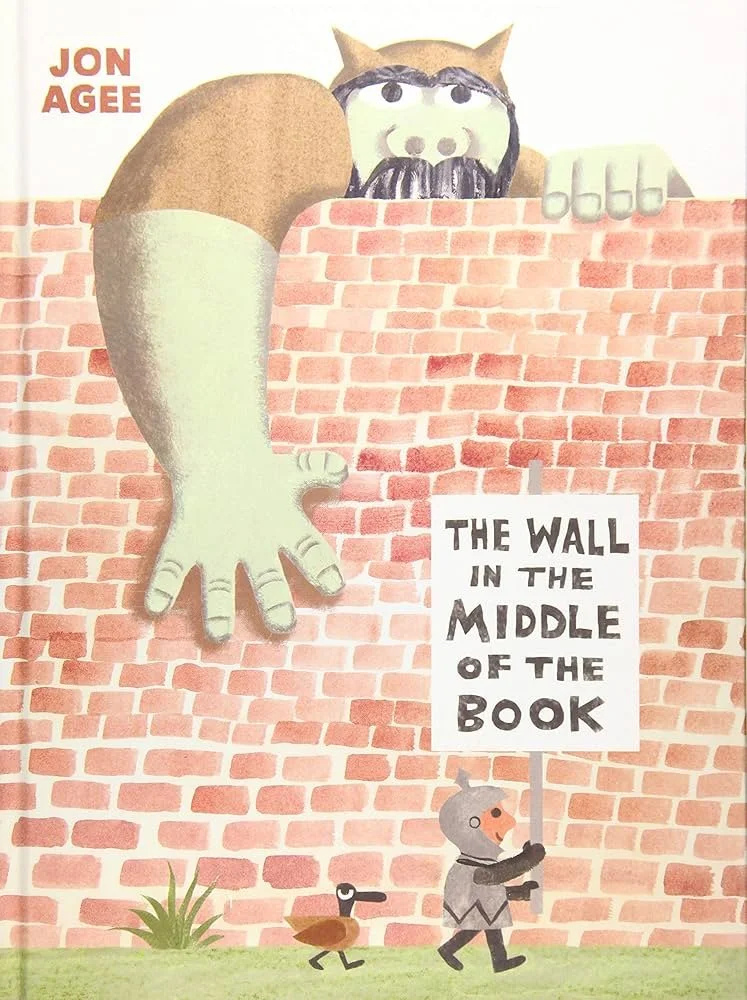
The Wall in the Middle of the Book
By Jon Agee
-
Jon Agee is a children's book writer and illustrator from the USA.
-
First published in 2018.
-
4-8
‘A book that celebrates freedom of movement and thought.’ Amnesty International.
The line between the pages is called a gutter and it at times is very annoying. Nobody likes it when pictures get damaged by it, when they roll and disappear in the gutter. But Jon Agee puts the gutter in the centre of the story. The book will be incomplete without it.
So what do you reckon the story is going to be about? There’s a giant but he doesn’t look scary although giants are traditionally to be feared. The tiny knight looks happy enough parading with a sign. Him and the duck seem to be oblivious.
If we think of a wall as a symbol, what will it mean? What is it to you? Is it protection? Barrier either keeping someone in or out? An obstacle? Boundaries?
One of the bricks is out. Is it a good thing or a bad thing? Most of the children in my class think it’s a bad thing. But we will see.
There’s a wall in the middle of the book.
This wall separates two worlds. Neither the knight nor the animals know what’s on the other side. They are being curious but I want to ask the students about the lion. I love it how Jon pictured it. It is hard to read. Is it bored? Tired? Is it worried? It looks like he is watching us and trying to say that the rhino is too silly and shouldn’t be climbing up there.
And it’s a good thing.
The knight is very happy that the wall is protecting him. He intends to fix it. What are the animals trying to achieve climbing over the wall?
The wall protects this side of the book…
What from? And the answer is very obvious. We can see the rhino, tiger, gorilla and even the mouse there. At least three out of four are pretty dangerous. The knight needs protection. We want him to be safe.
While talking to the children, I make it even more dramatic, I try to stick to the idea that the knight is in danger if the wall comes down. Of course he is.
We are as convinced the danger is over the wall as he is. And neither of us notice at first that his side is being flooded. And then we get it, we start worrying for him. But the little man is still sure he is safe. He is not expecting any danger coming from his side thinking it’s on the other side of the world.
The knight hears some noises coming from the other side and gets even more convinced that it’s dangerous. He can’t see what’s going on and doesn’t have a full picture. We do. And we might even want to laugh at them all. But do we always have a full picture in real life? Are we afraid of dangers that are on the other side? Do we only hear about them or read? Do we ever actually know everything or at least enough about the other world?
But the most dangerous thing on the other side of the book is the ogre.
We thought it’s a giant. Is it a mistake? Why do we think it’s a giant which is a neutral word, and he thinks it’s an ogre which has a disgusting connotation? Does the choice of words matter in this case?
While the knight is being smart and even looking like he knows something, the duck spots a crocodile. Just one snap and both of them are gone. But the danger is on the other side (sarcasm).
The duck gets eaten. Maybe not. Poor fella. The knight looks happy though because there’s a wall in the middle of the book, protecting him from the other side. Still oblivious to his surroundings.
When he eventually realises the situation, he is like ‘oh crumbs!’ The shock on his face tells us all. He is in denial. He can’t believe it something happened on his side of the wall.
He gets saved by the ogre. He does thank him but is still sure that he is in danger. The big ogre is meant to eat him up.
It’s nice how little creatures that we are not scared of at first on the knight’s side of the book turn out to be man-eating fish. And then every other animal that comes to the scene devours the smaller beast. Meanwhile, the ogre who is traditionally bad appears to be good.
I’ve also read another book by Amnesty International called The Enemy. I love them both for being so complex. You can read them with younger children and not go in depth. You can read them with more ready students and talk about propaganda and how we have a picture in our head and can’t believe it’s wrong even when we get evidence and facts.





